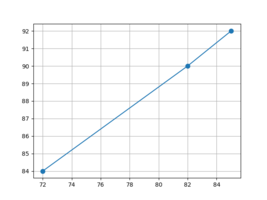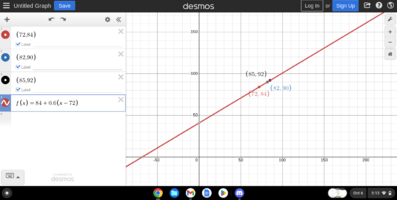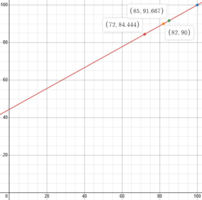You are using an out of date browser. It may not display this or other websites correctly.
You should upgrade or use an alternative browser.
You should upgrade or use an alternative browser.
Find unknown equation of grading curve from three points grades: 72->84, 82->90, and 85->92
- Thread starter Audentes
- Start date
BeachBanana
Senior Member
- Joined
- Nov 19, 2021
- Messages
- 2,281
No. There are various methods to curve grades, and the specific method used may not be apparent from the outcome alone.Hey, this is a bit theoretical. I'm wondering if its possible to find out how a curve was added to a random test, given 3 grades before and after.
72 -> 84
82 -> 90
85 -> 92
Thanks,
Aude
Ah, alright. Thank you!No. There are various methods to curve grades, and the specific method used may not be apparent from the outcome alone.
I actually got a pretty good model for the 70-100 range. Thanks!!
The are many functions f(x) such that f(72)=84, f(82) = 90 and f(85)=92.
Just plot the three points and see how many curves you can draw between them! Please try this.
blamocur
Elite Member
- Joined
- Oct 30, 2021
- Messages
- 3,223
Yup. Thanks!
Steven G
Elite Member
- Joined
- Dec 30, 2014
- Messages
- 14,603
First, that equation does not contain all three points.
2ndly, even if the three points did lie on a line there are still many many functions that cross those three points.
I know that three non-linear points lie on a unique circle.
A cubic equation will contain those three points.
...
2ndly, even if the three points did lie on a line there are still many many functions that cross those three points.
I know that three non-linear points lie on a unique circle.
A cubic equation will contain those three points.
...
Dr.Peterson
Elite Member
- Joined
- Nov 12, 2017
- Messages
- 16,865
Your linear function is a possible way the grades might have been calculated (rounding to the nearest whole number); but extrapolating beyond the interval from 72 to 85 would be very questionable.Yup. Thanks!
First, that equation does not contain all three points.
2ndly, even if the three points did lie on a line there are still many many functions that cross those three points.
I know that three non-linear points lie on a unique circle.
A cubic equation will contain those three points.
...
Yup, I used 100 and got way above 100. I think it *could* be stretched out to like 65 to 95Your linear function is a possible way the grades might have been calculated (rounding to the nearest whole number); but extrapolating beyond the interval from 72 to 85 would be very questionable.
Dr.Peterson
Elite Member
- Joined
- Nov 12, 2017
- Messages
- 16,865
Actually, it's just a little above 100, like 100.8. Which suggests that it's entirely possible that the teach may have chosen a linear "curve" that passes through (100,100):Yup, I used 100 and got way above 100. I think it *could* be stretched out to like 65 to 95
This is y = 100-(5/9)(100-x). With rounding, it gives the same results. (Are your data points real, or made up?)
Very interesting. Data points are real.Actually, it's just a little above 100, like 100.8. Which suggests that it's entirely possible that the teach may have chosen a linear "curve" that passes through (100,100):
This is y = 100-(5/9)(100-x). With rounding, it gives the same results. (Are your data points real, or made up?)
i've been testing 75 too, and been getting 86, this model is 86.11. I think you may have nailed it as per the original equation.
@Dr.Peterson
Whereas 75 on this model resulted in 85.8, not 86.11. Regardless, very close, but yours seems to be the exact one!



